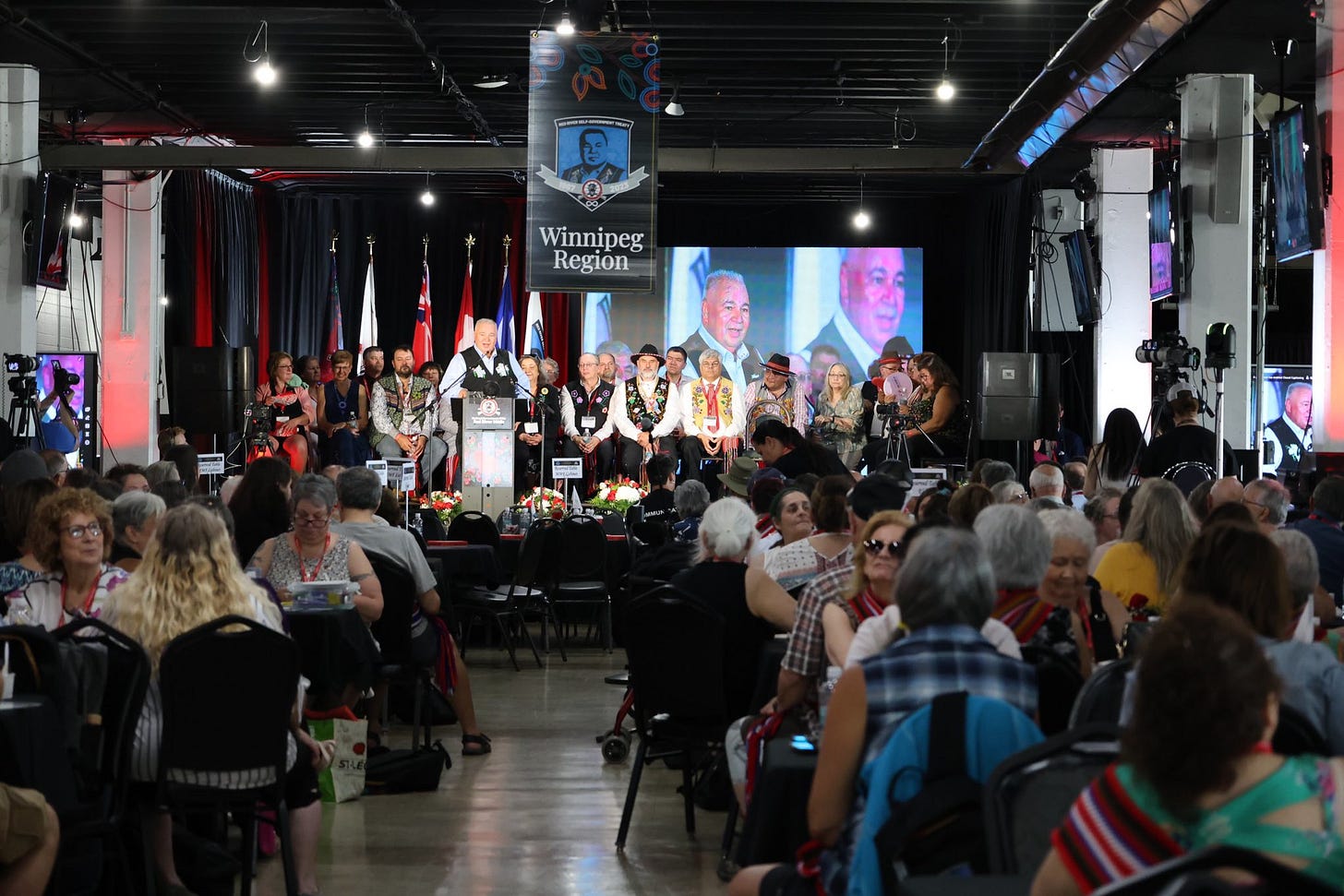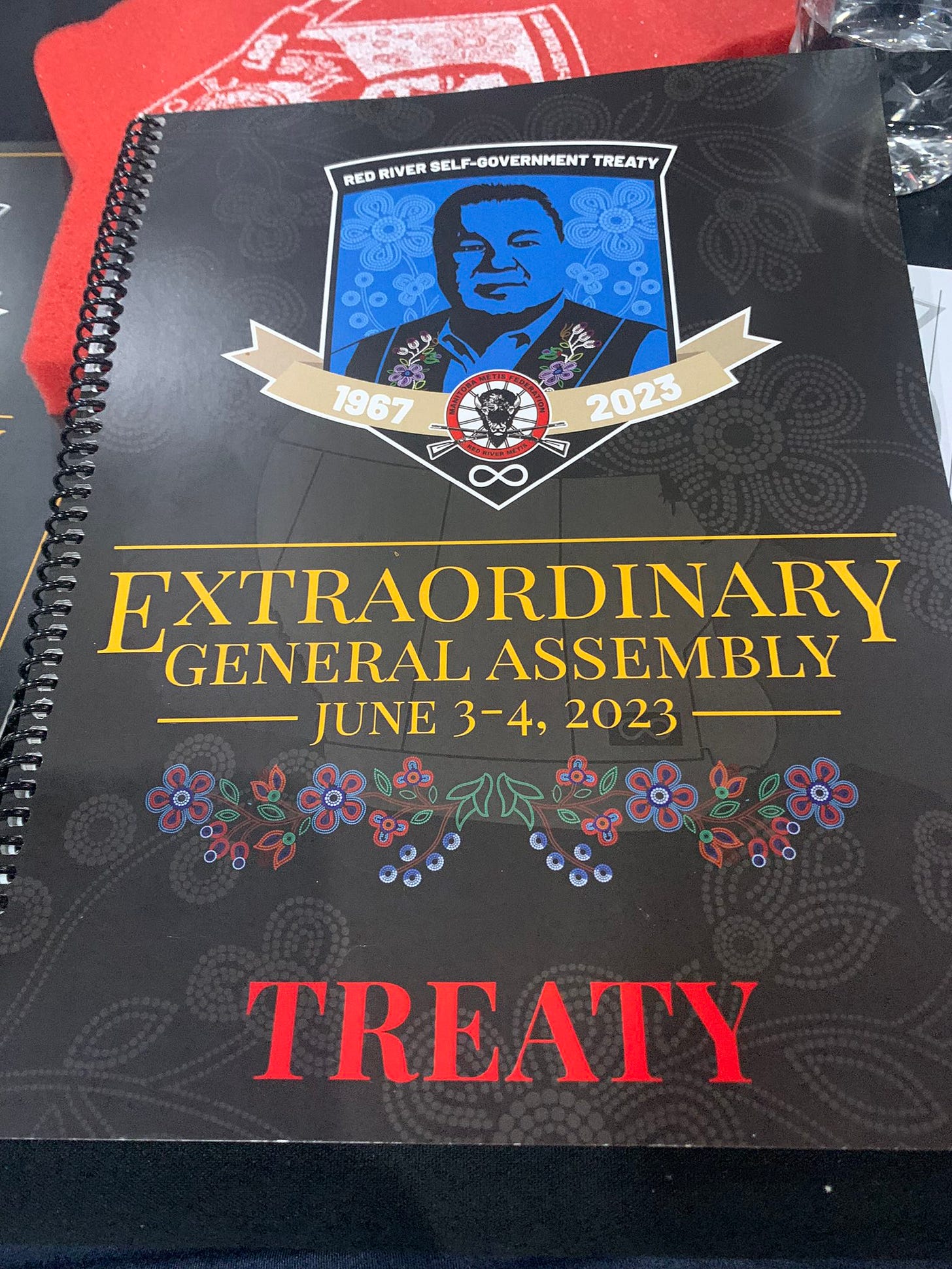Re-Share: A Vote 153 Years in the Making
My views of one of the most historically significant events in modern Canadian-Indigenous relations
I’m re-sharing this post on the second anniversary of the people of the Red River Metis Nation ratifying the Red River Métis Self-Government Recognition and Implementation Treaty. Update: On 30 November, 2024 the Manitoba Metis Federation and the Government of Canada signed the treaty. The next step required is for the Federal Government to pass legislation ratifying the Treaty.
It's not often I can say I was there when history was made, but on 3 June, 2023 I had the great privilege and honor to directly participate in one of the most historically significant events in modern Canadian-Indigenous relations.
During the weekend of 3-4 June 2023, I travelled to the great city of Winnipeg and, along with over 4000 fellow Red River Metis citizens who joined in-person or virtually from satellite locations stretching from Ottawa to Vancouver, I voted to ratify the Red River Métis Self-Government Recognition and Implementation Treaty.
Amid boisterous applause, cheers and not a few tears of joy, the co-chair of the Extraordinary General Assembly of the Manitoba Metis Federation (MMF), Will Goodon, declared a unanimous ratification of the treaty. This was a momentous and historic occasion that will shape the nature of relations between the Canadian federal government and the Red River Metis nation well into the future.
The Treaty was a long time coming. The Manitoba Act of 1870, which was the product of negotiations between the Provisional Government of Assiniboia, led by Louis Riel, and the Dominion Government, ended the Red River Resistance and brought the Province of Manitoba as well as the North West Territory into Canadian Confederation. Sections 31 and 32 of the Act guaranteed land claims to Metis citizens of the North West, but in the end, the Canadian government failed to live up to its constitutional obligations under the Act, as was determined by the Supreme Court of Canada in it’s 2013 decision in MMF v. Canada.
In response to this finding, in 2016 the MMF and the Canadian government entered into a Memorandum of Understanding to negotiate a resolution. The result was the Manitoba Metis Self Government Recognition and Implementation Agreement, signed in 2021, which formed the foundation of the modern day treaty and led directly to the Extraordinary General Assembly of Red River Metis citizens on 3-4 June, 2023.
The Treaty does not cover all points of contention between the Red River Metis nation and the federal government, but it does address important self-government jurisdictions such as citizenship, elections, structures, operations, procedures and financial accountability. It is unique and separate from treaties signed by First Nations, both historical and modern, and focusses on issues unique to Red River Metis but, importantly, does not alter Red River Metis citizens’ status as proud Canadian citizens as well.
While I would like to be able to write that this event was the culmination of a 153-year struggle, there are still important steps to take: the President of the MMF, David Chartrand, has been authorized by this ratification to sign the treaty alongside a minister representing Canada. Thereafter the Treaty’s implementation legislation must be passed by Parliament and receive royal assent, at which point it will come into effect.
Notwithstanding these important gateways yet to be achieved, the mass gathering of Metis citizens to ratify the Treaty resonates with historically similar events in Red River Metis culture and practice, such as the mass gatherings held in Fort Garry in December of 1869 to hear arguments for and against joining Confederation, and the deliberations of the Provisional Government of Assiniboia leading to the Manitoba Act and the unanimous ratification of that act by that same body on 24 June 1870.
It was a tremendous gift to be able to not only witness this ratification in person, but also to directly take part as a citizen. The emotions were high, and the excitement and, dare I say elation, were palpable. I was surrounded by fellow citizens who shared a common vision of a brighter future for the Metis nation as strong and supportive partners in the Canadian Confederation. Each Red River Metis citizen is as equally proud of their Metis citizenship as they are of their Canadian citizenship and I noted with pride the Manitoba Metis flag displayed on the dais alongside the flags of Canada and the Province of Manitoba.
One hundred and fifty years after the people of Red River debated the merits of joining Confederation, their beliefs and values are still openly discussed today. In that spirit, I am confident that 150 years from now, future generations will look back on this Extraordinary General Assembly and the unanimous ratification of the modern day treaty with a similar sense of awe and respect.
For more information on the Red River Métis Self Government Recognition and Implementation Treaty please see: FAQs | Manitoba Métis Federation (mmf.mb.ca)







You may have mentioned it but it also allows MMF to write laws for its RRM citizens provided they do not infringe on Canada’s lawmaking jurisdiction. For example, the MMF can confer RRM citizenship on those RRM living in the USA, but only Canada can give them Canadian citizenship.